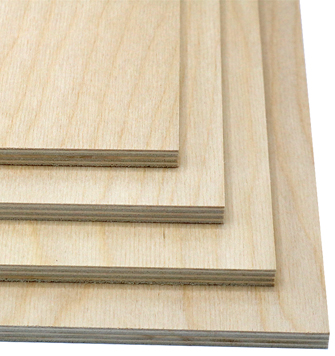
Plywood is a material manufactured from thin layers or “plies” of wood veneer that are glued together with adjacent layers having their wood grain rotated up to 90 degrees to one another. Plywood is a material manufactured from thin layers or “plies” of wood veneer that are glued together with adjacent layers having their wood grain rotated up to 90 degrees to one another.
All plywoods bind resin and wood fibre sheets (cellulose cells are long, strong and thin) to form a composite material. This alternation of the grain is called cross-graining and has several important benefits: it reduces the tendency of wood to split when nailed at the edges; it reduces expansion and shrinkage, providing improved dimensional stability; and it makes the strength of the panel consistent across all directions. There is usually an odd number of plies, so that the sheet is balanced—this reduces warping. Because plywood is bonded with grains running against one another and with an odd number of composite parts, it has high stiffness perpendicular to the grain direction of the surface ply.
Smaller, thinner, and lower quality plywoods may only have their plies (layers) arranged at right angles to each other.
Other types of plywoods include fire-retardant, moisture-resistant, wire mesh, sign-grade, and pressure-treated. However, the plywood may be treated with various chemicals to improve the plywood’s fireproofing.
Description
A – Face and back veneers practically free from all defects.
A/B – Face veneers practically free from all defects. Reverse veneers with only a few small knots or discolorations.
A/BB – Face as A but reverse side permitting jointed veneers, large knots, plugs, etc.
B – Both side veneers with only a few small knots or discolorations.
B/BB – Face veneers with only a few small knots or discolorations. Reverse side permitting jointed veneers, large knots, plugs, etc.
BB – Both sides permitting jointed veneers, large knots, plugs, etc.
C/C – For structural plywood, this grade means that the face has knots and defects filled in and the reverse may have some that are not filled. Neither face is an appearance grade, nor are they sanded smooth. This grade is often used for sheathing the surfaces of a building prior to being covered with another product like flooring, siding, concrete, or roofing materials.
Plywood is used in many applications that need high-quality, high-strength sheet material. Quality in this context means resistance to cracking, breaking, shrinkage, twisting and warping.
Exterior glued plywood is suitable for outdoor use, but because moisture affects the strength of wood, optimal performance is achieved where the moisture content remains relatively low. Subzero conditions do not affect the dimensional or strength properties of plywood, making some special applications possible.
Thickness: 1525 x 1525 mm, 1525 x 1475 mm, 2440 x 1220 mm, 1220 x 2440 mm, 1250 x 2500 mm
Size: 4 mm, 6 mm, 8 mm, 10 mm, 12 mm, 15 mm, 18 mm, 21 mm
Class: BB/BB, B/C, CP/CP/, CP/C, C/C

 +370 37 332445
+370 37 332445